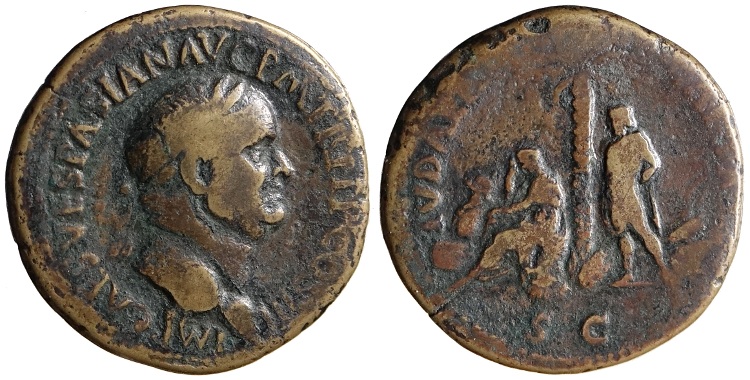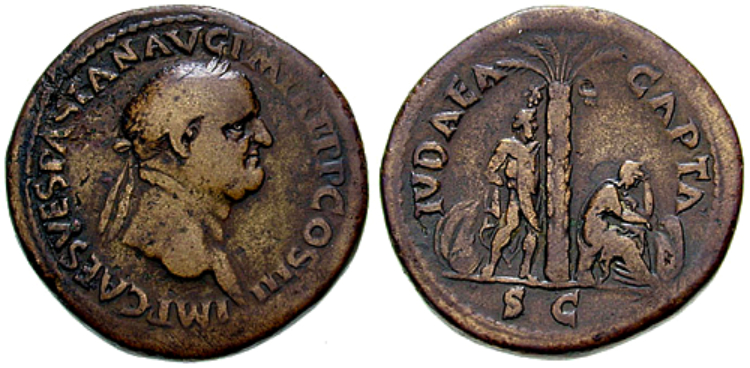Only us specialists foolishly care or notice such things.

Vespasian
Æ Sestertius, 23.94g
Rome mint, 71 AD
Obv: IMP CAES VESPASIAN AVG P M TR P P P COS III; Head of Vespasian, laureate, r.
Rev: IVDAEA CAPTA; S C in exergue; Palm tree; to l., Judaea std. l. on cuirass; to r., Captive stg. l.; both figures surrounded by arms
RIC 165 (R). BMC 540. BNC 494. Hendin 1502.
Acquired from Sebastian Sondermann, June 2023.
In 70 AD Jerusalem was besieged and sacked and the Temple razed by the Roman forces commanded by Titus Caesar. The following year a massive joint Triumph was held in Rome for Vespasian and Titus to celebrate their successful conclusion of the Jewish Rebellion. Coins were also issued to commemorate their victory. These so called ‘Judaea Capta’ coins first appeared in late 70 just after the fall of Jerusalem in August, both in the precious metals and at first sparingly in bronze. It wasn’t until 71, the year of the triumph, that the bronze coinage came into its own with a whole host of ‘Judaea Capta’ types. Probably the most famous of these depicts the ubiquitous date palm with a standing bound captive and a seated Judaea, both surrounded by arms. The second bronze issue of 71 saw these produced in massive quantities with a few different variations on the theme. This coin is a rarer variety featuring Judaea seated to the left of the palm and the standing captive to the right. It is more commonly encountered with the position of the figures reversed.
Modern viewers see this as a forlorn scene of defeat, however, to the Roman coin designers the images are meant to convey victory over a worthy foe. The Jewish War was an important event for the fledgling Flavian dynasty – in essence it gave them the legitimacy to rule. The ensuing propaganda onslaught after the ‘Gotterdammerung’ fall of Jerusalem is awe inspiring. The coins were a major part of the regime’s propaganda commemorating Vespasian’s defeat of the Jews and saving the empire. Their efforts paid off, for even today this ‘Judaea Capta’ type is one of the most iconic and recognised reverses in the whole of Roman coinage.
Here is the more common variety with the reverse figures switched.

Vespasian
Æ Sestertius, 26.69g
Rome mint, 71 AD
Obv: IMP CAES VESPASIAN AVG P M TR P P P COS III; Head of Vespasian, laureate, r.
Rev: IVDAEA CAPTA; S C in exergue; Palm tree; to l. Captive stg. r.; to r., Judaea std. r. on cuirass; both figures surrounded by arms
RIC 159 (C3). BMC 532. BNC 490, pl. XLIV (same dies). Hendin 1500.
Acquired from Witter Coins, eBay, October 2019. Ex Triton V, 16 January 2002, lot 1913 (From the Robert Schonwalter Collection). Ex Worner List 1, January 1951, no. 394. Formerly in NGC holder #4683650-005, with grade ‘F’, strike 5/5, surface 3/5.
